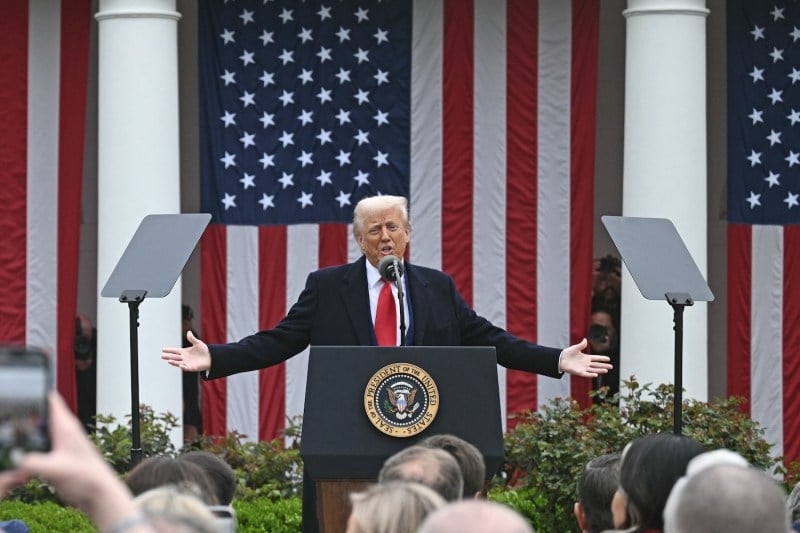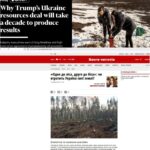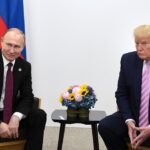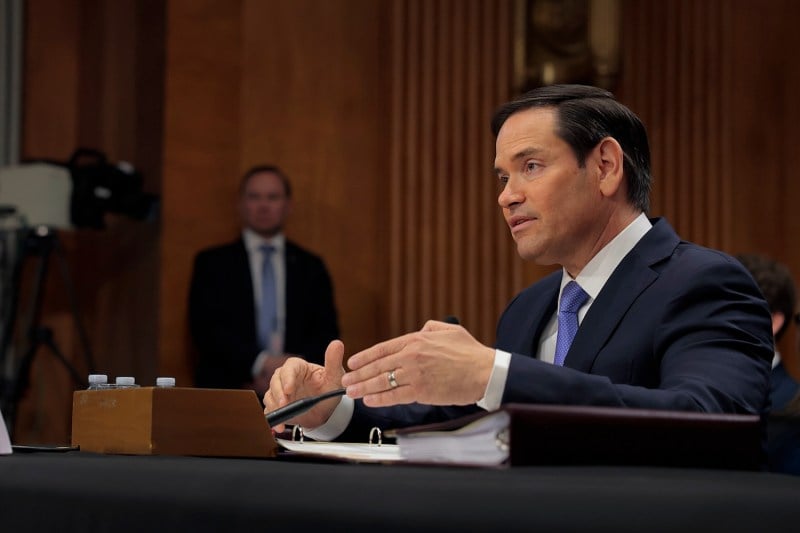Trump’s ‘Liberation Day’ Brings Even Bigger Tariffs Than Expected

Trump’s ‘Liberation Day’ Brings Even Bigger Tariffs Than Expected
Double-digit tariffs on nearly every trading partner will likely spark reprisals.
U.S. President Donald Trump delivers remarks on reciprocal tariffs during an event in the Rose Garden at the White House in Washington on April 2. Smialowski/AFP via Getty Images
U.S. President Donald Trump unveiled his most expansive tariffs yet, and what experts say could represent the biggest tax hike in modern U.S. history, in a long-promised move that could well slam the brakes on the U.S. economy and spark global reprisals.
Trump’s self-described “liberation day” announcement from the White House Rose Garden featured the most sweeping import duties yet from his administration: an ostensibly reciprocal tariff on all imports from abroad that will see duties ranging from a baseline of 10 percent to rates such as 46 percent on Vietnam.
U.S. President Donald Trump unveiled his most expansive tariffs yet, and what experts say could represent the biggest tax hike in modern U.S. history, in a long-promised move that could well slam the brakes on the U.S. economy and spark global reprisals.
Trump’s self-described “liberation day” announcement from the White House Rose Garden featured the most sweeping import duties yet from his administration: an ostensibly reciprocal tariff on all imports from abroad that will see duties ranging from a baseline of 10 percent to rates such as 46 percent on Vietnam.
The new baseline tariff will take effect on April 5, according to a White House fact sheet, and the higher reciprocal tariffs will be added on April 9. The barrage of new tariffs will be imposed under the Carter-era International Emergency Economic Powers Act, with Trump calling the current trade deficit a “national emergency.”
The tariffs will nominally add anywhere from $400 billion to $800 billion, or potentially more, to the annual tax burden on U.S. businesses and consumers, in addition to shrinking export opportunities as countries from Asia to Europe respond in kind. U.S. stock index futures fell after the announcement, with those tracking Nasdaq down by more than 2 percent.
Trump presented the move as a way to simultaneously raise tax revenue (he spoke of “trillions and trillions of dollars” in tariff-related income) to offset his planned tax cuts, reshore U.S. manufacturing, and rebalance a global trade playing field he and his trade team say has been systematically tilted against the United States for years. (Meanwhile, public support for free trade has surged since Trump took office a second time.)
“Foreign countries have looted, pillaged, and raped” America by imposing unfair trade practices, Trump said. “This is one of the most important days in American history. It is the declaration of American independence,” Trump added. “Jobs and factories will come roaring back, and America will be wealthy again.”
The latest measures, which Trump presented as reciprocal tariffs against all trade partners (“in many cases, the friend is worse than the foe,” Trump said), add another layer of import duties onto the more than $4 trillion worth of goods and services that the United States imports each year and come atop already announced duties on steel, aluminum, cars, Mexico, Canada, and China. More could also be coming: Trump has hinted at further “sectoral” tariffs that could jack up prices for particular imports, such as pharmaceuticals and chips.
The new tariffs seem to be even harsher than anticipated, with most market expectations previously looking at a flat rate of perhaps 15 percent on all U.S. trading partners. Trump’s proposal takes aim at both tariff barriers—that is the tariff rate that other countries levy on imports—but also harder-to-calculate measures such as currency manipulation, industrial subsidies, regulatory and phytosanitary standards, and even foreign domestic taxes. That will raise economists’ eyebrows as well as almost inevitable challenges at the World Trade Organization (WTO).
Trump showed a chart with some of the so-called reciprocal rates that he said would go into effect this month, including 34 percent on China, 20 percent on the European Union, 32 percent on Taiwan, 24 percent on Japan, 26 percent on India, 25 percent on South Korea, and 36 percent on Thailand. (All of those countries except China are formal or nominal U.S. treaty allies or security partners.) The rates were calculated, Trump said, as half the rate set by other countries on U.S. imports, though how he made the calculation wasn’t immediately clear.
Trump’s measures are all but certain to trigger painful countermeasures from Europe, with European Commission President Ursula von der Leyen warning on Tuesday that European leaders “have a strong plan to retaliate” and “will use it,” if needed.
“Europe holds a lot of cards, from trade to technology to the size of our market,” she said. “But this strength is also built on our readiness to take firm countermeasures if necessary. All instruments are on the table.”
Even before Wednesday’s announcement, Trump had ratcheted U.S. average tariff rates to their highest level since the 1940s, when U.S. officials helped build the global trading system with the goal of fostering freer trade and avoiding damaging trade wars (and real ones as well). The latest batch would push U.S. tariffs up to levels last seen after the Hoover-era tariffs of the early 1930s, a tax hike and trade wallop that economists say exacerbated the Great Depression. Despite Trump’s statements at his Rose Garden conference, the average trade-weighted tariff rate of all WTO members is about 3.8 percent.
Economists have been steadily ramping down their U.S. and global growth outlooks as a result of Trump’s escalating trade war, with some big investment banks now putting the chances of a recession at a 35 percent to 40 percent likelihood. By some measures, economic uncertainty in the United States is now higher than during the COVID-19 pandemic.
Inflation will rise, at least in the short term, due to the inability of many firms to source goods from anywhere other than overseas and a limited ability, in many industries, to absorb massive cost increases to their own inputs. Some economists expect unemployment to nearly double.
Markets have already lost all the post-election gains they had posted. Trump delayed his big announcement on Wednesday until U.S. markets had closed. Asian markets will open just hours after his announcement.
One big difference between the latest batch of tariffs and all the previous rounds is that they really will affect almost everyone, not just particular sectors, such as steel and cars, although those industries will now face additional costs. Farmers will face higher prices for fertilizer just ahead of planting season, as well as the likely prospect that once massive export markets such as China will become no-go zones.
“Farmers on both sides of the Atlantic are feeling the stress and uncertainty from the threat of tariffs,” Rob Larew, the president of National Farmers Union, the United States’ second-largest general farm organization, warned last month. “Trade tensions will raise costs, disrupt supply chains and restrict markets causing farmers, consumers and businesses alike to suffer.”
Clothes, too, will get more expensive, since the $100 billion-a-year of U.S. apparel imports will now be subject to tariffs not just on goods from China but from all the countries that have sold textiles in China’s stead, such as Vietnam.
Meanwhile, there is likely to be little short- to medium-term revival in U.S. manufacturing because of the tariffs, which, if past is prologue, could be used as negotiating leverage and be removed at a White House whim. Many plants, such as those in the auto or aluminum industries, require multibillion-dollar investments and years of lead time; other industries don’t have skilled workers or could only be competitive reshoring if they resort to even more automation, which could negate any blue-collar employment gains.
“For companies looking for clarity, they should assume this is the start of the process, not the end,” said Ryan Petersen, the CEO of Flexport, a supply chain manager, who stressed that some of the tariffs could be bargaining chips, not absolute metrics. “Businesses are looking for clarity so they can make investment decisions on their supply chains … and the reality is that they will likely have to wait for the process to play out before they can really understand the new landscape of global trade.”
Wednesday’s sweeping tariffs may not be the worst of it, with the novel idea of “secondary tariffs” suddenly all the rage in Washington. Trump has already threatened tariffs on any country that buys oil from Venezuela (that would affect U.S. goods imports from China) and floated the idea of similar tariffs on Iranian crude exports. Legislation introduced in the Senate Tuesday would levy 500 percent tariffs on any country that buys Russian gas or oil, which would put the EU, or at least some of its member states, under the threat of crushing financial penalties.
Trump ran on the idea of sharply increasing import taxes, and in a few short months in office, he has delivered far more than he did during his first term. He alluded on Wednesday to his promises to bring back a winning recipe for the U.S. economy, which until 2025 was the best performing after COVID of all major economies in the world.
FP’s Lili Pike and Christina Lu contributed reporting.
Keith Johnson is a reporter at Foreign Policy covering geoeconomics and energy. X: @KFJ_FP
More from Foreign Policy
-

An illustration shows a golden Cybertruck blasting through a U.S. seal of an eagle holding arrows and laurel. Is America a Kleptocracy?
Here’s how life could change for the rich, poor, and everyone in between.
-

The flag of the United States in New York City on Sept. 18, 2019. America Is Listing in a Gathering Storm
Alarms are clanging at the U.S. geographic military commands around the globe.
-

U.S. President Donald Trump shakes hands with Supreme Court Chief Justice John Roberts during Trump’s inauguration in Washington, D.C. The U.S. Judicial Crisis Is Uniquely Dangerous
But other democracies provide a roadmap for courts to prevail over attacks from the executive branch.
-

An illustration shows a golden Newtons cradle with Elon Musk depicted on the one at left and sending a globe-motif ball swinging at right. Elon Musk’s First Principles
The world’s richest man wants to apply the rules of physics to politics. What could go wrong?










Join the Conversation
Commenting on this and other recent articles is just one benefit of a Foreign Policy subscription.
Already a subscriber?
.
Subscribe
Subscribe
View Comments
Join the Conversation
Join the conversation on this and other recent Foreign Policy articles when you subscribe now.
Subscribe
Subscribe
Not your account?
View Comments
Join the Conversation
Please follow our comment guidelines, stay on topic, and be civil, courteous, and respectful of others’ beliefs.
Change your username |
Log out
Change your username:
CANCEL
Confirm your username to get started.
The default username below has been generated using the first name and last initial on your FP subscriber account. Usernames may be updated at any time and must not contain inappropriate or offensive language.